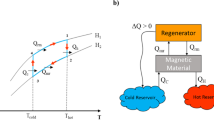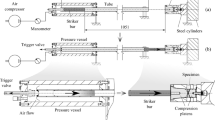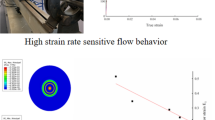Abstract
The thermo-mechanical behavior of a La(Fe,Co,Si)13 thin film deposited on a porous aluminum structure with a uniform geometry has been studied. Computational simulation techniques have been applied to the magnetocaloric material to model the thin film as a material with visco-plastic properties for thermal cycling at room temperature. The values obtained for stress, equivalent strain and cycles necessary for the material failure show a significant improvement in the mechanical stability and fatigue resistance of the metallic porous structure with the La(Fe,Co,Si)13 thin film, when compared to a model with the same geometry, but made entirely of La(Fe,Co,Si)13. These encouraging results prove the potential that this approach may have in the design and manufacture of magnetocaloric materials for magnetic refrigeration applications.
You have full access to this open access chapter, Download conference paper PDF
Similar content being viewed by others
Keywords
1 Introduction
Refrigeration plays a crucial role in a large part of industrial and residential sectors, since the consumption related to thermal management systems is around 30% of the total electricity produced worldwide [1]. Furthermore, current vapor-compression refrigeration systems contribute significantly to global warming due to the release of polluting gases into the atmosphere, such as CO2 and fluorocarbons commonly used as refrigerants, also demonstrating a poor efficiency in the Carnot cycle (around 10%).
As an environmentally friendly alternative, magnetic refrigeration (MR) has attracted scientific interest as a novel technology with the potential to achieve efficiencies of up to 60% with zero emissions of greenhouse gases [2]. MR is based on the magnetocaloric effect (MCE), which is the response exhibited by a magnetic material when its magnetic moments tend to align parallel to an applied external magnetic field, yielding an increase in its temperature. The magnetic moments then become randomly oriented when the magnetic field is removed, causing the material to cool down [3].
When developing MR systems, characteristics such as a transition temperature close to room temperature (Curie temperature), first-order magneto-structural transition, zero toxicity, good thermal conductivity, and a high surface area-to-volume ratio [4] must be considered. At the same time, excellent mechanical stability during refrigeration cycles, as well as good ductility and strength, are critical requirements.
Recent investigations [4] have used metal additive manufacturing techniques for the fabrication of MR systems, showing that conforming magnetocaloric materials as uniform porous structures helps maximize heat transfer between the solid refrigerant and the working fluid, while minimizing fluid pressure drop. Also, the possibility of using thin films of magnetocaloric materials deposited on substrates such as metallizations or polymers, has been studied [5]. This configuration can preserve the magnetic and thermal properties of the material, with a non-significant reduction in its MCE.
However, it remains a challenge to ensure a certain degree of ductility and mechanical stability of magnetocaloric materials, as well as fatigue resistance by the normal thermal cycle. As an alternative to improve the mechanical behavior of MR materials, while maintaining its magnetocaloric properties, the objective of this work is to evaluate the thermo-mechanical stress suffered by thin films of a magnetocaloric material when deposited on a porous metallic structure with a uniform geometry, using modeling and computational simulation methods. In particular, La(Fe,Co,Si)13 is the alloy of choice as it has a considerable MCE, a manageable Curie temperature in the range of 250 K to 340 K, as well as relatively good mechanical fatigue stability [6].
For the thermo-mechanical stress study, COMSOL Multiphysics software has been used, where the behavior of the magnetocaloric material is modeled as a medium with visco-plastic properties. The fatigue resistance of the material is then calculated using the Morrow model for dissipated energy in defined volumes. Two scenarios were developed: 1) a porous structure made entirely of La(Fe,Co,Si)13., and 2) a thin film of La(Fe,Co,Si)13 deposited on a porous aluminum structure. Using the numerical results, the performance of the magnetocaloric material in both approaches was compared.
2 Computational Methods
Tensile and compression behaviors of La(Fe,Co,Si)13 give a brittle failure with the formation of multiple cracks during the tests and prior to total failure [7, 8]. When analyzing the cracks orientation with respect to the load direction, two failure mechanisms are recognized: 1) fracture due to rupture originated because of transverse tensile stresses parallel to the load, and 2) shear stress fracture created at a 45° angle with respect to the applied force. Both types of fracture are commonly observed in semi- or brittle materials, such as rocks, ceramics, or marble, where they exhibit time-dependent inelastic deformations [9]. Hereby, the mechanical behavior of La(Fe,Co,Si)13 can be modeled as a material with visco-plastic properties and crack-induced damage.
Under this approach, the thermo-mechanical stress is solved using the Chaboche model for visco-plastic materials, coupled with the Rankine equivalent deformation model for scalar damage. The magnetization–demagnetization cycle is modeled as a thermal load in the range of 250 K to 340 K with a cycling frequency of 2 Hz. Finally, fatigue resistance is calculated with the Morrow model for defined volumes.
The geometric pattern of the material consists of a foam-like cellular structure with a matrix of regularly distributed spheres (pores), each one with a diameter of 5 mm and separation distance of 4mm between their centers (Fig. 1(a). The thin film of magnetocaloric material is modeled as a membrane structure with a thickness of 100 nm.
2.1 Mathematical Model
The visco-plastic strain rate tensor of Chaboche visco-plastic model [10] is given by
where A is the coefficient of the visco-plastic change rate (1/s), n is the stress exponent, \(\sigma_{ref}\) is the reference stress level (Pa), and nD is the tensor coaxial to the stress tensor. The yield function inside the Macaulay brackets in Eq. 1 is defined as
where the equivalent stress \(\phi \left( \sigma \right)\) is the von Mises stress. The nD tensor is calculated by the visco-plastic potential \(Q_{vp} = F_y\) when the von Mises equivalent stress is used. G If nD:nD = 3/2, the change rate of the visco-plastic strain is finally determined by
On the other hand, the Rankine damage model [11] defines the equivalent strain from the largest undamaged principal stress \(\sigma_{p1}\) as
where E is the Young’s modulus. In this formulation, Macaulay brackets are used to emphasize the fact that only (positive) tensile stresses can cause damage.
Morrow’s expression for fatigue is an exponential relationship given by
where \(\Delta W_d\) is the range of energy density dissipated during one cycle, \(N_f\) is the number of cycles until material failure, and \(W^{\prime}_f\) and m are constants of the material.
2.2 Initial and Boundary Conditions
If the thermal load applied is uniform throughout the material, the model geometry can be simplified to the structure shown in Fig. 1(b), with a symmetry condition given to each surface and edge of the model. The mechanical and thermal properties of the magnetocaloric material needed for the analysis are summarized in Table 1 [7, 8].
3 Results and Discussion
For the scenarios analyzed, i.e. the porous structure made entirely of La(Fe,Co,Si)13, and the thin film of La(Fe,Co,Si)13 deposited on a porous aluminum structure, the resulting Von Misses stress are shown in Figs. 2 and 3 gives the equivalent deformations, while the cycles needed for material failure are depicted in Fig. 4.
Following Fig. 2, stress concentration occurs where the structural link between pores is thinner (less than a 1 mm of bulk material). For scenario 1, von Mises stress at those links exceeds 30 MPa (Fig. 2(a)), but for scenario 2 (Fig. 2(b)), stresses in the thin film of the magnetocaloric material are below the 15 MPa. This behavior is also found in the equivalent deformation results, where the highest change rate in the volume of the La(Fe,Co,Si)13 structure for scenario 1 (Fig. 3(a)) occurs at the same spatial points, with a value of 21.19 × 10–4 mm/mm. Instead, the thin film of the same material but for scenario 2 deforms around 48 × 10–6 mm/mm (Fig. 3(b)). The cycles required in scenario 1 for material failure are approximately 5690 (Fig. 4(a)), which falls short if compared to the fatigue resistance of conventional refrigeration systems (1 × 106 cycles until material failure [7]). For scenario 2, the thin film of La(Fe,Co,Si)13 material collapses at approximately 200,000 cycles (Fig. 4(b)), with the thin film being the structure that suffers the rupture, since the aluminum porous structure preserves its integrity practically intact.
For the results obtained in both scenarios, the significant decrease in the values of stress and deformation of the La(Fe,Co,Si)13 thin layer, if compared with the structure of scenario 1, are a consequence of the aluminum core present in the model for scenario 2, as it imposes to a large extent its mechanical behavior over the magnetocaloric material. Also, the similar thermal expansion coefficients of both Al and La(Fe,Co,Si)13, assure that the deformations they suffer during magnetic cycling, due to the expansion-contraction phenomenon caused by the temperature change, does not become a source of significant stresses in the magnetocaloric thin film behavior, since the rate at which their volumes change remains relatively close to each other. Finally, these characteristics causes a significant increase in the number of minimum cycles needed for structural failure of the La(Fe,Co,Si)13 thin film. Although it is a great improvement, it still does not reach the performance of conventional refrigeration processes but allowing this approach to be considered as a viable alternative when designing and implementing MR systems with enhanced mechanical stability.
4 Conclusions
Thermo-mechanical and fatigue behaviors of a thin layer of La(Fe,Co,Si)13 deposited in a porous aluminum structure were evaluated. The values of stress, equivalent deformation and cycles needed for material failure of the structure were computed for two scenarios: the porous structure made entirely of La(Fe,Co,Si)13, and the thin film of La(Fe,Co,Si)13 deposited on a porous aluminum structure. The results yielded that the composition in the second scenario have greater mechanical stability and resistance to fatigue if compared to the structure of scenario 1, since its stress and deformation values decrease by a significant amount, while the cycles needed for material failure increase almost 40 times. This outcome shows the potential to create metal-based MR materials with uniform geometries coated with thin layers of magnetocaloric alloys, making this approach a feasible option for the development of enhanced MR systems.
References
Silva, D., Ventura, J., Araújo, J.: Caloric devices: a review on numerical modeling and optimization strategies. Int. J. Energy Res. 45(13), 18498–18539 (2021)
Balli, M., Sari, O., Zamni, L.: Implementation of La(Fe, Co)13−xSix materials in magnetic refrigerators: practical aspects. Mater. Sci. Eng. B 177, 629–634 (2012)
Bouchekara, H., Nahas, M.: Magnetic Refrigeration Technology at Room Temperature. de Trends in Electromagnetism – From Fundamentals to Applications. Research Gate (2014)
Moore, J., Klemm, D., Lindackers, D.: Selective laser melting of La(Fe Co, Si)13 geometries for magnetic refrigeration. J. Appl. Phys. 114, 043907 (2013)
Krautz, M., Funk, A., Skokov, K.: A new type of La(Fe, Si)13-based magnetocaloric composite with amorphous metallic matrix. Scripta Mater. 95, 50–53 (2015)
Lyubina, J., Schäfer, R., Martin, N.: Novel design of La(Fe, Si)13 alloys towards high magnetic refrigeration performance. Adv. Mater. 22, 3735–3739 (2010)
Rosendahl, B., Kuhn, L., Bahl, C.: Properties of magnetocaloric La(Fe Co, Si)13 produced by powder metallurgy. J. Magn. Magn. Mater. 322, 3447–3454 (2010)
Glushko, O., Funk, A., Maier-Kiener, V.: Mechanical properties of the magnetocaloric intermetallic LaFe11.2Si1.8 alloy at different length scales. Acta Materialia 165, 40–50 (2019)
Zhou, H., Jia, Y., Shao, J.F.: A unified elastic–plastic and viscoplastic damage model for quasi-brittle rocks. Int. J. Rock Mech. Mining Sci. 45(8), 1237–1251 (2008)
Ambroziak, A., Klosowski, P.: The elasto-viscoplastic Chaboche Model. Task Q. 10(1), 49–61 (2007)
ComsolAB: COMSOL Multiphysics – Structural Mechanics Module, User’s Guide (2020)
Author information
Authors and Affiliations
Corresponding author
Editor information
Editors and Affiliations
Rights and permissions
Open Access This chapter is licensed under the terms of the Creative Commons Attribution 4.0 International License (http://creativecommons.org/licenses/by/4.0/), which permits use, sharing, adaptation, distribution and reproduction in any medium or format, as long as you give appropriate credit to the original author(s) and the source, provide a link to the Creative Commons license and indicate if changes were made.
The images or other third party material in this chapter are included in the chapter's Creative Commons license, unless indicated otherwise in a credit line to the material. If material is not included in the chapter's Creative Commons license and your intended use is not permitted by statutory regulation or exceeds the permitted use, you will need to obtain permission directly from the copyright holder.
Copyright information
© 2023 The Author(s)
About this paper
Cite this paper
Rodríguez-Méndez, F., Chiné, B., Meneses-Guzmán, M. (2023). Thermo-mechanical Stress Modeling of La(Fe,Co,Si)13 Thin Films Deposited on Porous Structures. In: Vizán Idoipe, A., García Prada, J.C. (eds) Proceedings of the XV Ibero-American Congress of Mechanical Engineering. IACME 2022. Springer, Cham. https://doi.org/10.1007/978-3-031-38563-6_13
Download citation
DOI: https://doi.org/10.1007/978-3-031-38563-6_13
Published:
Publisher Name: Springer, Cham
Print ISBN: 978-3-031-38562-9
Online ISBN: 978-3-031-38563-6
eBook Packages: EngineeringEngineering (R0)








